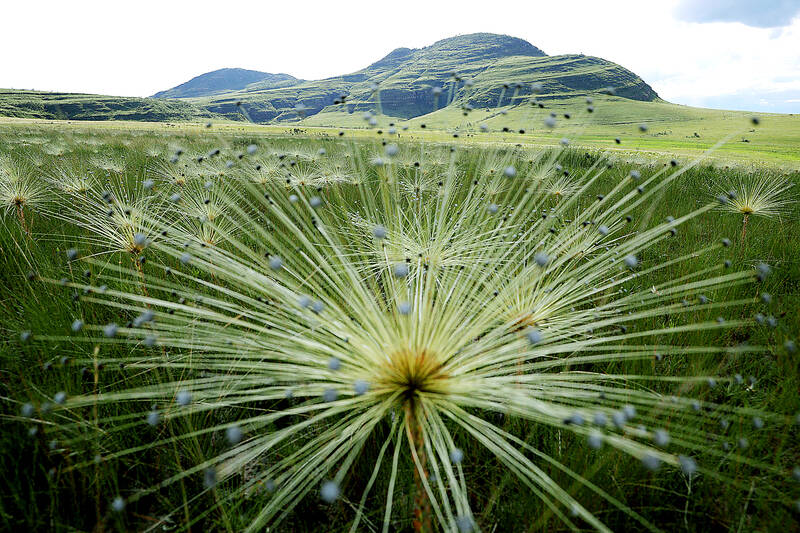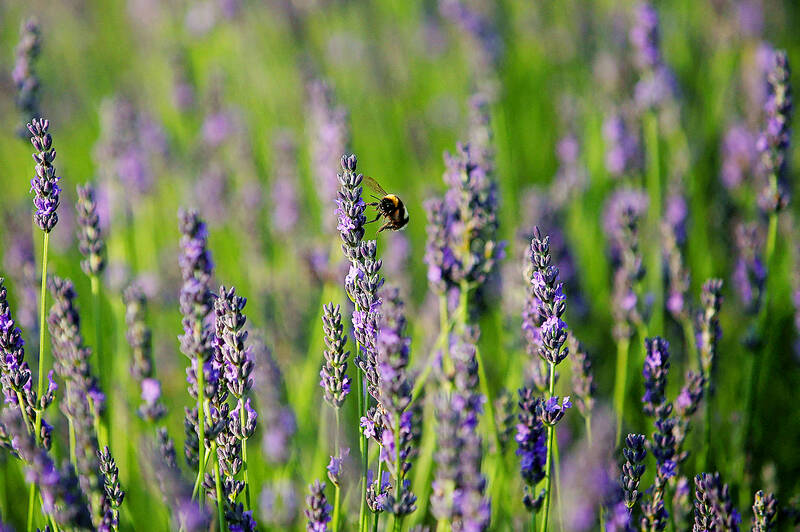Nearly 800 plant species have disappeared since the 18th century, while thousands more are considered functionally extinct — no longer playing a role in their environment, or are so rare they are no longer able to reproduce.
Scientists at the Royal Botanic Gardens, Kew in the UK estimate undocumented extinctions could put the number much higher.
“Most plant extinctions happen silently,” with plant populations vanishing without people noticing until the absence starts to take its toll on nature, said Eimear Nic Lughadha, a conservation researcher at Kew.

Photo: Reuters
Losing plants is concerning because “we don’t know what was depending on that species in the ecosystem,” Nic Lughadha said. “And we don’t know what that species could be used for in the future.”
With the world’s remaining jungles and boreal forests still being destroyed to make way for things such as livestock, palm oil plantations or urban development, at least 40 percent of the world’s remaining plant species are in trouble, according to Kew’s 2020 State of the World’s Plants and Fungi report.
GREEN PLANET

Photo: Reuters
From the monkey-faced orchids and woody vines of the tropics to the boreal pixie-cup lichen and spearmoss carpeting the Arctic tundra, the world contains around 423,000 plant species on land — about 78 times the number of recorded mammal species.
Altogether, this greenery represents 82 percent of the weight of all living things.
But plants can be trickier to assess than animals, as botanists can’t follow a plant’s footprints across a savannah or listen for mating calls through a tangled forest.
As a result, scientists have assessed the extinction risk of only about 15 percent of species. That means we’re often not sure what the world is losing until it’s too late.
Within the plant kingdom, flowering plants — or angiosperms — make up the most diverse group at more than 369,000 species, and include colorful species such as Japanese wisteria and the Eastern redbud tree.
Among ferns and mosses there are nearly 34,000 species.
Conifers, or gymnosperms, such as the Douglas fir and Western hemlock, number just over 1,100 species.
PREVENTING EXTINCTION
About two plant species vanish each year on average. That’s 500 times faster than the natural rate of extinction, scientists reported in a 2019 study in the journal Nature Ecology & Evolution.
Island-growing plants are at greatest risk because “there’s nowhere to escape to,” Nic Lughadha said.
In recent decades, scientists have worked globally to save and protect rare plants.
“There’s no technological reason why any plant species should go extinct today,” said Colin Clubbe, a senior researcher at Kew, standing in the gardens’ Temperate House, which he dubs “a cathedral to plants.”
Unfortunately, conservation efforts were not far enough along to save the Saint Helena olive tree. The stout and shrubby plant with its clutches of tiny pink flowers once grew on a South Pacific island before going extinct in 2003.
“So you’ve got a tombstone for it as a species. But there’s still hope we might one day find a surviving individual,” he said.
For centuries, scientists have been refining their knowledge about the world’s plant species by revisiting old survey sites and carrying out new ambitious field studies. They have managed to rediscover 537 plants thought to be extinct, according to Kew.
A Chilean crocus, Tecophilaea cyanocrocus, was found sprouting south of Santiago in 2001, for example — decades after the species was written off as a casualty of over-collecting by Victorian-era gardeners.
Even better, since the mid-2000s, scientists have been cataloging between 2,100 and 2,600 new species every year — far outpacing the number of plants that have vanished.
PLANTING FOR THE FUTURE
Scientists have now spent decades in sterile laboratories carefully cultivating the remaining individuals of vanishing species and saving seeds in enormous vaults. With an immense array of scientific tools at their disposal, it’s time to start planning for what comes next, scientists said.
Some botanists have even begun discussing outplanting species beyond their known native range as a hedge against climate change.
World leaders are attending a two-week meeting in Montreal, Canada, and hope to develop a global strategy for protecting and conserving nature before COP15 closes on Dec. 19.
One of the key aims is for countries to set aside 30 percent of their land for protection in the next seven years — providing potential safe havens for plants.
“We need to be looking out from the laboratories and out from the botanic gardens and into” the wild for restoration, said Clubbe. “We want to get them planted out and back into their historic distribution.”

Sept.16 to Sept. 22 The “anti-communist train” with then-president Chiang Kai-shek’s (蔣介石) face plastered on the engine puffed along the “sugar railway” (糖業鐵路) in May 1955, drawing enthusiastic crowds at 103 stops covering nearly 1,200km. An estimated 1.58 million spectators were treated to propaganda films, plays and received free sugar products. By this time, the state-run Taiwan Sugar Corporation (台糖, Taisugar) had managed to connect the previously separate east-west lines established by Japanese-era sugar factories, allowing the anti-communist train to travel easily from Taichung to Pingtung’s Donggang Township (東港). Last Sunday’s feature (Taiwan in Time: The sugar express) covered the inauguration of the

The corruption cases surrounding former Taipei Mayor and Taiwan People’s Party (TPP) head Ko Wen-je (柯文哲) are just one item in the endless cycle of noise and fuss obscuring Taiwan’s deep and urgent structural and social problems. Even the case itself, as James Baron observed in an excellent piece at the Diplomat last week, is only one manifestation of the greater problem of deep-rooted corruption in land development. Last week the government announced a program to permit 25,000 foreign university students, primarily from the Philippines, Indonesia and Malaysia, to work in Taiwan after graduation for 2-4 years. That number is a

In a stark demonstration of how award-winning breakthroughs can come from the most unlikely directions, researchers have won an Ig Nobel prize for discovering that mammals can breathe through their anuses. After a series of tests on mice, rats and pigs, Japanese scientists found the animals absorb oxygen delivered through the rectum, work that underpins a clinical trial to see whether the procedure can treat respiratory failure. The team is among 10 recognized in this year’s Ig Nobel awards (see below for more), the irreverent accolades given for achievements that “first make people laugh, and then make them think.” They are not

This Qing Dynasty trail takes hikers from renowned hot springs in the East Rift Valley, up to the top of the Coastal Mountain Range, and down to the Pacific Short vacations to eastern Taiwan often require choosing between the Rift Valley with its pineapple fields, rice paddies and broader range of amenities, or the less populated coastal route for its ocean scenery. For those who can’t decide, why not try both? The Antong Traversing Trail (安通越嶺道) provides just such an opportunity. Built 149 years ago, the trail linked up these two formerly isolated parts of the island by crossing over the Coastal Mountain Range. After decades of serving as a convenient path for local Amis, Han settlers, missionaries and smugglers, the trail fell into disuse once modern roadways were built